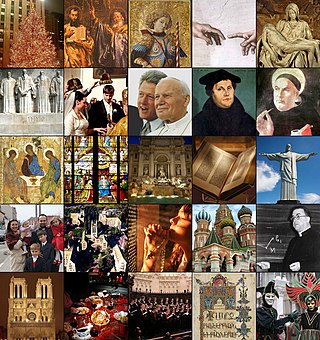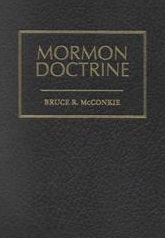
Chastity, also known as purity, is a virtue related to temperance. Someone who is chaste refrains either from sexual activity that is considered immoral or from any sexual activity, according to their state of life. In some contexts, for example when making a vow of chastity, chastity means celibacy.

Mormons are a religious and cultural group related to Mormonism, the principal branch of the Latter Day Saint movement started by Joseph Smith in upstate New York during the 1820s. After Smith's death in 1844, the movement split into several groups following different leaders; the majority followed Brigham Young, while smaller groups followed Joseph Smith III, Sidney Rigdon, and James Strang. Most of these smaller groups eventually merged into the Community of Christ, and the term Mormon typically refers to members of the Church of Jesus Christ of Latter-day Saints, as today, this branch is far larger than all the others combined. People who identify as Mormons may also be independently religious, secular, and non-practicing or belong to other denominations. Since 2018, the LDS Church has emphasized a desire for its members be referred to as "members of The Church of Jesus Christ of Latter-day Saints", or more simply as "Latter-day Saints".

The basic beliefs and traditions of the Church of Jesus Christ of Latter-day Saints have a cultural impact that distinguishes church members, practices and activities. The culture is geographically concentrated in the Mormon Corridor in the United States, and is present to a lesser extent in many places of the world where Latter-day Saints live.
Sexuality has a prominent role within the theology of the Church of Jesus Christ of Latter-day Saints. In its standards for sexual behavior called the law of chastity, top LDS leaders bar all premarital sex, all homosexual sexual activity, the viewing of pornography, masturbation, overtly sexual kissing, sexual dancing, and sexual touch outside of a heterosexual marriage. LDS Leaders teach that gender is defined in premortal life, and that part of the purpose of mortal life is for men and women to be sealed together in heterosexual marriages, progress eternally after death as gods together, and produce spiritual children in the afterlife. The church states that sexual relations within the framework of monogamous opposite-sex marriage are healthy, necessary, and approved by God. The LDS denomination of Mormonism places great emphasis on the sexual behavior of Mormon adherents, as a commitment to follow the law of chastity is required for baptism, adherence is required to receive a temple recommend, and is part of the temple endowment ceremony covenants devout participants promise by oath to keep.

The Miracle of Forgiveness is a book written by Spencer W. Kimball while he was a member of Quorum of the Twelve Apostles of the Church of Jesus Christ of Latter-day Saints. He later became the church's president.

All homosexual sexual activity is condemned as sinful by the Church of Jesus Christ of Latter-day Saints in its law of chastity, and the church teaches that God does not approve of same-sex marriage. Adherents who participate in same-sex sexual behavior may face church discipline. Members of the church who experience homosexual attractions, including those who self-identify as gay, lesbian, or bisexual remain in good standing in the church if they abstain from same-sex marriage and any homosexual sexual activity or sexual relationships outside an opposite-sex marriage. However, all people, including those in same-sex relationships and marriages, are permitted to attend the weekly Sunday meetings.

The Church of Jesus Christ of Latter-day Saints focuses its doctrine and teaching on Jesus Christ; that he was the Son of God, born of Mary, lived a perfect life, performed miracles, bled from every pore in the Garden of Gethsemane, died on the cross, rose on the third day, appeared again to his disciples, and now resides, authoritatively, on the right hand side of God. In brief, some beliefs are in common with Catholics, Orthodox and Protestant traditions. However, teachings of the LDS Church differ significantly in other ways and encompass a broad set of doctrines, so that the above-mentioned denominations usually place the LDS Church outside the bounds of orthodox Christian teaching as summarized in the Nicene Creed.

In the Church of Jesus Christ of Latter-day Saints, a temple is a building dedicated to be a House of the Lord. Temples are considered by church members to be the most sacred structures on earth.

The following outline is provided as an overview of and a topical guide to the Church of Jesus Christ of Latter-day Saints.
On many occasions spanning over a century, leaders of the Church of Jesus Christ of Latter-day Saints have taught that adherents should not masturbate as part of obedience to the code of conduct known as the law of chastity. This denomination within Mormonism places great emphasis on the sexual behavior of Mormon adherents as a commitment to follow the law of chastity is required for baptism, and adherence is required to receive a temple recommend, and is part of the temple endowment ceremony covenants devout participants promise by oath to keep. A 2011 church manual quotes former church president Spencer W. Kimball who taught that the law of chastity includes "masturbation ... and every hidden and secret sin and all unholy and impure thoughts and practices." Before serving full-time missions, young adults are required to abandon the practice as it is believed to be a gateway sin that dulls sensitivity to the guidance of the Holy Ghost. The first recorded public mention of masturbation by a general church leader to a broad audience was in 1952 by apostle J. Reuben Clark, and recent notable mentions include in 2016, 2019, and 2021.

Soaking is a sexual practice of inserting the penis into the vagina but not subsequently thrusting or ejaculating, reportedly used by some members of the Church of Jesus Christ of Latter-day Saints. News sources do not report it being a common practice, and some Latter-day Saints have said that soaking is an urban legend and not an actual practice. Others report knowing church members who had soaked.

Because of its ban against same-sex sexual activity and same-sex marriage the Church of Jesus Christ of Latter-day Saints has a long history of teaching that its adherents who are attracted to the same sex can and should attempt to alter their feelings through righteous striving and sexual orientation change efforts. Reparative therapy is the pseudoscientific practice of attempting to change an individual's sexual orientation from homosexual or bisexual to heterosexual, or their gender identity from transgender to cisgender using psychological, physical, or spiritual interventions. There is no reliable evidence that such practices can alter sexual orientation or gender identity, and many medical institutions warn that conversion therapy is ineffective and potentially harmful.

Over the past two centuries, the relationship between Native American people and Mormonism has included friendly ties, displacement, battles, slavery, education placement programs, and official and unofficial discrimination. Native American people were historically considered a special group by adherents of the Latter Day Saint movement (Mormons) since they were believed to be the descendants of the Lamanite people described in The Book of Mormon. There is no support from genetic studies and archaeology for the historicity of the Book of Mormon or Middle Eastern origins for any Native American peoples. Today there are many Native American members of Mormon denominations as well as many people who are critical of Mormonism and its teachings and actions around Native American people.
This is a timeline of LGBT Mormon history in the 1950s, part of a series of timelines consisting of events, publications, and speeches about LGBTQ+ individuals, topics around sexual orientation and gender minorities, and the community of members of the Church of Jesus Christ of Latter-day Saints. Although the historical record is often scarce, evidence points to queer individuals having existed in the Mormon community since its beginnings. However, top LDS leaders only started regularly addressing queer topics in public in the late 1950s. Since 1970, the LDS Church has had at least one official publication or speech from a high-ranking leader referencing LGBT topics every year, and a greater number of LGBT Mormon and former Mormon individuals have received media coverage.
This is a timeline of LGBT Mormon history in the 1960s, part of a series of timelines consisting of events, publications, and speeches about LGBTQ+ individuals, topics around sexual orientation and gender minorities, and the community of members of the Church of Jesus Christ of Latter-day Saints. Although the historical record is often scarce, evidence points to queer individuals having existed in the Mormon community since its beginnings. However, top LDS leaders only started regularly addressing queer topics in public in the late 1950s. Since 1970, the LDS Church has had at least one official publication or speech from a high-ranking leader referencing LGBT topics every year, and a greater number of LGBT Mormon and former Mormon individuals have received media coverage.
This is a timeline of LGBT Mormon history in the 1970s, part of a series of timelines consisting of events, publications, and speeches about LGBTQ+ individuals, topics around sexual orientation and gender minorities, and the community of members of the Church of Jesus Christ of Latter-day Saints. Although the historical record is often scarce, evidence points to queer individuals having existed in the Mormon community since its beginnings. However, top LDS leaders only started regularly addressing queer topics in public in the late 1950s. Since 1970, the LDS Church has had at least one official publication or speech from a high-ranking leader referencing LGBT topics every year, and a greater number of LGBT Mormon and former Mormon individuals have received media coverage.
This is a timeline of LGBT Mormon history in the 1980s, part of a series of timelines consisting of events, publications, and speeches about LGBTQ+ individuals, topics around sexual orientation and gender minorities, and the community of members of the Church of Jesus Christ of Latter-day Saints. Although the historical record is often scarce, evidence points to queer individuals having existed in the Mormon community since its beginnings. However, top LDS leaders only started regularly addressing queer topics in public in the late 1950s. Since 1970, the LDS Church has had at least one official publication or speech from a high-ranking leader referencing LGBT topics every year, and a greater number of LGBT Mormon and former Mormon individuals have received media coverage.

Homosexuality has been publicly discussed by top leaders in the Church of Jesus Christ of Latter-day Saints —Mormonism's largest denomination—since the late 1800s. The frequency of teachings on same-sex sexual activity increased starting in the late 1950s. Most discussion focuses on male homosexuality and rarely mentions lesbianism or bisexuality. Below is a timeline of notable speeches, publications, and policies in the LDS church on the topic of homosexuality.












